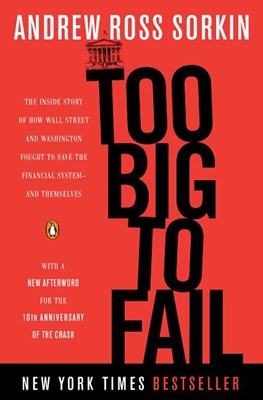Too Big to Fail: The Inside Story of How Wall Street and Washington Fought to Save the Financial System—And Themselves by Andrew Ross Sorkin, Viking Books, 624 pages, $32.95, Hardcover, October 2009, ISBN 9780670021253
Even though
Too Big to Fail was written during the same year as the recent financial collapse occurred, Andrew Ross Sorkin has written what I predict will be the definitive book on the subject. It not only tells a gripping "perfect storm" story—with all the gory details as our 401k's disappeared and our financial system became nationalized included—but the author humanizes all the players, resulting in an imminently readable, albeit lengthy, book.
Each of the major players are shown here—warts and all. Sorkin takes us inside of Henry Paulson's mind as the Secretary of the Treasury tries to get a grip on the collapse of the investment banks. We see Timothy Geithner "clearly overwhelmed, his eyes darting around his office as he nervously twisted a pen between his fingers." And Ben Bernanke who sits "politely nodding in his best professorial manner."
Most riveting are Sorkin's descriptions of the meetings between the government representatives and the heavy-hitting and heavily-hit CEOs, bringing to mind Bryan Burrough and John Helyar's classic,
Barbarians at the Gate. Sorkin describes a call to arms between financial competitors to save such institutions as Lehman, Bank of America, and AIG before the government would get involved this way: "The CEOs had all been milling about, tapping away on their BlackBerrys, and pouring themselves cups of ice water to cool themselves from the miasma of humidity that hung in the [New York Federal Reserve Building]. After the meeting, "the bankers left expressionless and mute, dumbstruck at the magnitude of the work that lay before them."
Sorkin does not act as only a dispassionate observer, however, and includes his own informed deductions. "Unless those regulations are changed radically ... there will continue to be firms that are too big to fail. And when the next, inevitable bubble bursts, the cycle will only repeat itself." It's a sobering reflection, but a critical reminder that there is still extreme risk involved when there is extreme reward at stake.
For this kind of book to work, the secret is effective story telling. Bob Woodward has done this kind of reporting for years, and Theodore White's great
The Making of the President series that started in 1960 is the father of the genre. Now Andrew Sorkin has now joined them. Great stories, detailed insider information; it is what places this book among the greats.


